
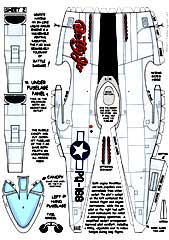


North American P-82 Twin Mustang - $$5.95
Flying in formation with itself... The immense distances between islands in the Pacific Theater required a fighter type that could fly for hours between islands, yet have its pilot fresh for combat at any time. The North American solution was its P-82 Twin Mustang. Unique concept.
North American P-82 Twin Mustang
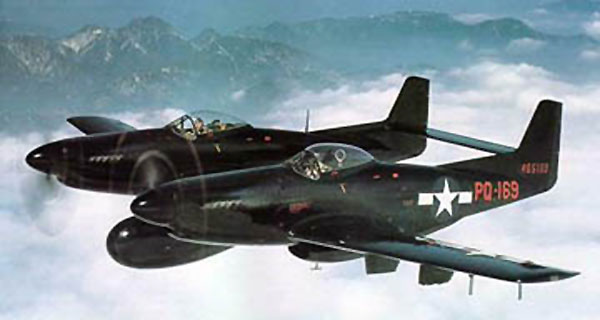

Appearing from some angles to be two P-51's flying in a close formation the North American P-82/F-82 was very nearly exactly that! Rather than develop an entirely new model from scratch, North American found that it could meet the requirements by joining two standard P-51 fuselages with a new center wing section and horizontal tail.
Saving time, money, and materials North American produced 250 of the double-fuselage airplanes for the Air Force, embracing three versions of the Twin Mustang then in service, the P-82E, P-82F and P-82G. They were ordered too late for World War II, however.
An F-82, an F-82, I can't believe it!!! I reckon you guys may have just cured my burn out. This is what I love about you guys, not the usual, typical planes, but rather the more unique planes out there, FG just carries on surprising me, awesome stuff!! Niki
 |
This is a beta
of the P-82 Twin Mustang in it's early stages |
Oh Boy! Oh Boy! Another Fiddlersgreen Winner!
Remembrances:
Years ago we had a Korean War P-82 pilot give a lecture at an IPMS meeting about the F-82 and his combat time hitting enemy trains before they ran for cover in tunnels. I remember him stating that the twin Mustang was based on the P-51 Mustang but it was really a new design and that his had cockpit controls only on one side. The other contained the radar operator. Sharpening blades and waiting for the Fiddlers design team to complete this one, Bob Penikas
 The
P-82 (Changed to F-82 in 1948 when the Army Air Corps became
the U.S.A.F.) was more of a modification than just "stretching"
the fuselage. The engine cowling was lengthened to incorporate
the tandem variable-pitch gear box and also sported a close-profile
air intake.
The
P-82 (Changed to F-82 in 1948 when the Army Air Corps became
the U.S.A.F.) was more of a modification than just "stretching"
the fuselage. The engine cowling was lengthened to incorporate
the tandem variable-pitch gear box and also sported a close-profile
air intake.
The tail section of the fuselage was extended some 12% to
accommodate some pitch problems they incorporated on earlier
tests. The landing gear... Well, that's obvious. And full
flight controls were taken out of the Starboard cockpit to
make room for radio (radar) instrumentation and advanced bomb
sights. Full IFR was left in the Port cockpit only.
The vertical stabilizer sported an elongated dorsal fillet
to improve "tracking" stability and wouldn't slide
so much in a hard bank. Even the wing-roots were modified
because of an overall shortened span (by comparison to the
P-51). It no longer had that distinguishable "angle"
where the wing meets the fore-fuselage. But hey... The canopy
stayed the same!!!

Howdy, The paper parts had been cut out but
there was a row of empty soda cans nearby, the late night
talk radio station had an interesting conversation in progress,
and, well, converting this new Fiddlersgreen design from
paper to aluminum just seemed so natural. Bob Penikas
NOTE: The BETA version of this model came with a shorter fuselage than it should have been and the submitted photos above reflect this error (our bad). The model has been re-drawn for its release.
1.The p-82 sheets look great but I don't see any wing
fairing's? You should check all the different models,
I see 2 different ones with a center section like for
the German tug but only 2 fuselages.
2. I take my WWII disc to Kinko's and have them blow
it up to 11" x 17". It makes great models.
3. I want to order the Bomber CD and will order the
Hard copy version so I can blow them up. What are the
chances that you will make revisions to them? Thanks,
I'll keep making them and you keep designing them..
Bennett
++Bennett
We chose to drop the fairing's from the design for a
little more simplicity.. The P-82 has fairing's built
into the fuselage and that seemed to be sufficient.
and YES.. We're making changes (updates, new versions,
corrections) to ALL the Cds ALL the time. Just yesterday,
I corrected a part on the Camo version of the B-52 and
uploaded it to all the folders of guys who 'own' it.
Truth be known tho, the Bombers CD has been around from
quite some time and changes are few and far between.
Model on!!
North American F-82/P-82

The versatility of the P-82 (F-82) made it potentially adaptable to a wide variety of roles in modern aerial warfare. It was adapted as a fighter, a long-range escort, long-range reconnaissance, night fighter, attack bomber, rocket fighter and an interceptor.With a speed of more than 475 miles an hour, the Twin Mustang had a combat range of over 1,600 miles with full armament. Range could be extended by use of external drop tanks on the wings.
In January of 1944, the USAAF ordered four prototypes of the P-82 Twin Mustang. This unusual fighter would have a maximum range of 2,600 miles, which was 300 miles more than the P-51D, and over the Pacific Ocean every mile would be precious.
More
importantly, the P-82 carried two pilots who could relieve each
other during missions that might last as long as nine hours. But
it is interesting to note that only the pilot in the left fuselage
had full IFR instruments. On such missions in the "soup," the
second pilot would be able to provide little in the way of relief.
Both engine throttles and both propellers were controllable from either cockpit by manually operated levers. The pilot's cockpit on the left contained the normal flight and engine instruments, while the co-pilot on the right had sufficient instruments for relief and emergency operation. A simplified cockpit arrangement improved pilot comfort, including a tilting, adjustable seat to reduce fatigue during long flights.
On June 27, 1950, shortly after the beginning of the Korean War, an F-82G from the 68th F(AW)S of the 8th Fighter Bomber Wing shot down a North Korean Yak fighter near Kimpo Air Field north of Seoul. This became the first aerial kill of the war and the first scored by a pilot in the United States Air Force. The F-82G was flown by Lt. William Hudson, and the radar observer was Lt. Carl Fraser. In addition to this first, the Twin Mustang became the last propeller-driven fighter ordered into production by the United States Air Force.
 Most F-82s were produced as all-weather night fighters, with the first being the F-82F. |
|
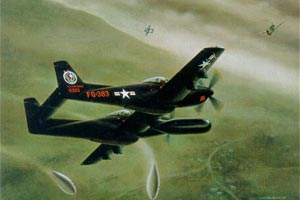 |
 |
A
radical departure from the conventional single-fuselage
airplane, the Twin Mustang was formed by two fuselages joined
by the wing and the horizontal stabilizer. With a pilot
in each fuselage, it reduced to a minimum the problem of
pilot fatigue on ultra-long-range missions. The P-82F and
G models carried a radar operator in the right cockpit instead
of a co-pilot. |
|
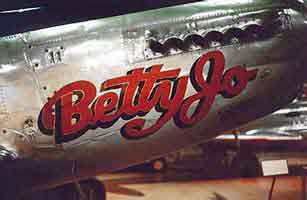 Close up of the cowling details with the beautiful "Betty Jo" P-82 Twin Mustang in bold lip-stick red. |
 P-82 Twin Mustang on display today at the Wright Patterson U.S. Air Force Museum in Dayton, Ohio |
North American produced 250
of the double-fuselage airplanes for the Air Force, embracing
three versions of the Twin Mustang then in service, the
P-82E, P-82F and P-82G. They were ordered too late for World
War II, however.
Both engine throttles and
both propellers were controllable from either cockpit by
manually operated levers. The pilot's cockpit on the left
contained the normal flight and engine instruments, while
the co-pilot on the right had sufficient instruments for
relief and emergency operation. A simplified cockpit arrangement
improved pilot comfort, including a tilting, adjustable
seat to reduce fatigue during long flights.
|
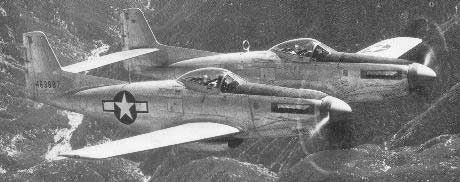 The
P-82 was renamed the F-82 in 1948, and a The
P-82 was renamed the F-82 in 1948, and a U.S. F-82 shot down the first enemy aircraft of the Korean War. |
 |
 |
 |
Well I've eventually finished the model. As is usual with me I struggled with the curvature of the air intake bottoms and also the wing fairing's. This is one aspect of card modeling I always struggle with. If you have any magic words of wisdom I would appreciate them. One idea I have is that perhaps the card I am using is slightly too thick. It is 160gm. I really love the landing gear! They work really well. I must say that I really look forward to rebuilding the model when you finally release it. I am including a few photos of my model. Neither the model or the photos are the greatest, but they will give you an idea of what sort of job an average Joe will do. George Burgess |
| Notes to George..You're right! #160 is way too thick and that certainly is your problem trying to bend small parts. Try #67 from Wall-Marts. For tricky curves, it helps to slightly moisten (hot breath is sufficient!) and then form over a tea spoon. | |
  Thanks to give me the possibility to make this test building! I will assemble the black version (night fighter). Emil Enchev from Bulgaria |
|
 Scans of the P 82 are attached, they came out better then I thought they would. I put a little red paper dot on the tip of the spinners, they look much better |
 |
  P-82 Twin Mustang Beta (now revised with a longer fuselage).... Bob Dennison |

The North American P-82 Twin Mustang was
the last version in the evolution of the Mustang design, and
was developed to satisfy the requirement for a long range
escort fighter to accompany bombers to targets in Japan.
In early 1947, one aircraft., serial no.
|
Specifications for the North American P-82/F-82 Twin Mustang
 |
Crew: 2 Length: 42 ft 9 in Wingspan: 51 ft 3 in Height: 13 ft 10 in Wing area: 408 ft² Empty weight: 15,997 lb Max takeoff weight: 25,591 lb Powerplant: 2× Allison V-1710-143/145 counter-rotating liquid-cooled V12 engines, 1,380 hp takeoff each Performance Maximum speed: 482 mph at 21,000 ft Range: 2,350 mi Service ceiling: 38,900 ft Armament Guns: 6 × .50 in (12.7 mm) Browning M2 machine guns Rockets: 25 × 5 in (127 mm) rockets Bombs: 4,000 lb |
 |
North American P-82 Twin Mustang Cutaway. |
 |
||
| A: Like the wartime P-51 , the prototype P-82 was powered by the Packard Merlin V-12 liquid cooled engine, but production aircraft used Allison V-1710s. | B: The crew sat on adjustable seats, designed to a levitate the discomfort of long patrols. Both cockpits had complete controls, but only the pilots cockpit to port, had full instruments. | C: The Twin Mustang had a long dorsal fin to improve stability. The pilot could uncouple the rudder pedals if need be in order to stretch his legs safely without moving the rudder. |
| D: The Large SCR 720C or APS-4 radar was carried in an under fuselage pod. the operator sat in the starboard cockpit. | E: The F-82 could carry underwing fuel to extend its already impressive range. Offensive armament of four 1,000 lb. bombs or rockets could also be carried. The six machine guns were wing mounted. | F: The fuselage for the F 82 vr: lengthened P-51H design. Center of gravity problems meant that ammunition storage was limited to less than the capacity of 1,800 rounds. |




 The
Mustang's combat record is generally considered to consist
of: 4,950 air kills, 4,131 ground kills and 230 V-1 kills,
with an 11:1 "kill ratio"
The
Mustang's combat record is generally considered to consist
of: 4,950 air kills, 4,131 ground kills and 230 V-1 kills,
with an 11:1 "kill ratio"